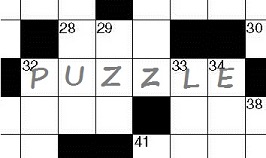
Previous Month | RSS/XML | Current | Next Month
WEBLOG
November 23rd, 2023 (Permalink)
A Puzzle to be Thankful For
Six members of the Blanc family, including Doug and Edwina, were gathered around the big round dining room table for Thanksgiving dinner. Following family tradition, each had brought a different dish for the meal, including stuffing. From the following clues, can you determine where each family member sat and what dish each brought?
Clues:
- Abner sat directly opposite the family member who brought cranberry sauce, who sat to the immediate right of Doug's sibling.
- Claudia sat between Doug's sibling and the family member who brought the pecan pie, and opposite the person who brought the turkey, who sat next to the one who brought cranberry sauce.
- The family member who brought a pecan pie sat between Claudia and Beatrix, who sat directly opposite Doug's sibling and supplied the mashed potatoes.
- Ferdinand, who is not Doug's brother, sat next to the person who brought the cranberry sauce and opposite the one who brought a green bean casserole.
Starting arbitrarily at Abner and continuing around the table clockwise, here are each family member and the dish they brought: Abner, pecan pie; Beatrix, mashed potatoes; Ferdinand, turkey; Doug, cranberry sauce; Edwina, Doug's sister, stuffing; and Claudia, green bean casserole.
November 17th, 2023 (Permalink)
Headline
Idaho teacher arrested for rape of teen cops found driving her car because she was too ‘drunk to drive’*
She raped teen cops?
*Olivia Land, "Idaho teacher arrested for rape of teen cops found driving her car because she was too ‘drunk to drive’", The New York Post, 11/16/2023

November 8th, 2023 | Update: 11/9/2023 (Permalink)
Is it time to panic yet?
New polling, conducted by The New York Times (NYT) and Siena College, shows former President Trump beating current President Biden in five out of six "critical" states that Biden won in 20201, namely, Arizona, Georgia, Michigan, Nevada and Pennsylvania. The only "battleground" state where Biden leads is Wisconsin. As you'd expect, there's been considerable hand-wringing in certain circles2.
Given that these are state results, it's obvious that the samples for each state must be some fraction of the total sample, which raises the question of what the margin of error (MoE) is for each state. However, the poll has an unusually large sample, namely, 3,662 registered voters and, as a result, the MoEs range from ±4.4 to 4.8 percentage points. This is larger than the usual ±3 points of most national polls, but not enormously so.
Let's look at the results for the individual states and compare them to the MoEs3:
- Arizona: Trump leads by five percentage points, which is barely outside the MoE of ±4.4 points.
- Georgia: Trump leads by six points, which is moderately outside the MoE of ±4.5 points.
- Michigan: Again, Trump leads by five points, barely outside the MoE of ±4.4 points.
- Nevada: Trump leads by eleven points, which is over twice the MoE of ±4.4 points and, so, probably not due to sampling error.
- Pennsylvania: Trump leads by four points, which is barely within the MoE of ±4.6 points.
- Wisconsin: Biden leads by two points, which is well within the MoE of ±4.8 points.
Except for Nevada, these are not particularly striking results, and could be individually explained as the result of sampling error. What should be more worrisome to Democrats is the general trend in favor of Trump, especially given that these are considered "key" states for Biden to win.
If we assume that each state is currently a toss-up between Biden and Trump, then the probability of Trump leading in at least five states is about 11%, so we can be about 89% confident that the results are not due to chance4. That doesn't necessarily mean that the results accurately portray current public opinion, just that they are not likely due to random sampling error. Alternatively, they may be the result of a systematic bias in the poll.
Given that the poll was sponsored by the NYT, it's unlikely that the results can be explained by political bias, but there are many other ways that polls can be biased. However, the hypothesis of bias is undermined by the fact that another recent poll also has Trump leading Biden5.
There's almost exactly a year to go before the next presidential election, and given the current volatility of the world―including the possibility of the United States getting dragged into a war―a lot can change between now and then. So, to answer my own title question: no, it's not time to panic yet. But if you're a Democrat, you'd better start worrying.
Update, 11/9/2023: I didn't see this coming: Emerson College just today released the results from new state polls similar to the one discussed above6. Emerson surveyed the same six "swing" states with the biggest difference being that Wisconsin and Michigan were switched, that is, Trump leads in the former while Biden is ahead in the latter.
Emerson made a point of polling a thousand registered voters in each state but, unlike the NYT/Siena poll, it used an online panel rather than a random probability sample. As a result, the usual confidence interval calculation does not apply; instead, Emerson reports a "credibility interval" of ±3 percentage points, which is supposed to be similar to a MoE. How this is justified, I don't know, but the similarity of Emerson's results to those of the NYT/Siena poll, which used a probability sample, is reassuring.
Let's examine the individual results for registered voters (RV) and "likely" voters (LV)7:
| State | RV | LV |
|---|---|---|
| Arizona | Trump+2 | Trump+2 |
| Georgia | Trump+7 | Trump+8 |
| Michigan | Biden+2 | Biden+2 |
| Nevada | Trump+7 | Trump+3 |
| Pennsylvania | Trump+3 | Trump+4 |
| Wisconsin | Trump+1 | Tie |
These two polls, both conducted at about the same time, reinforce each other's results. Whatever, if anything, is wrong with these results, it's obviously not due to the methodologies of either poll, which were quite different.
I still think it's way too early to panic, but the case for panic is getting stronger.
Notes:
- Shane Goldmacher, "Trump Leads in 5 Critical States as Voters Blast Biden, Times/Siena Poll Finds", The New York Times, 11/5/2023.
- Michael D. Shear, "Democrats Express Deep Anxiety as Polls Show Biden Trailing Trump", The New York Times, 11/5/2023.
- "Cross-Tabs: October 2023 Times/Siena Poll of the 2024 Battlegrounds", The New York Times, 11/5/2023.
- I figured this probability using Pascal's triangle―see: H. Wheeler, "Pascal's Triangle in Probability", Utah State University, Fall 2018―then checked the result with the following calculator: Maciej Kowalski, "Coin Flip Probability Calculator", Omni Calculator, 5/22/2023.
- Maggie Astor, "The Times/Siena Poll Isn’t the Only One Indicating an Unhappy Electorate", The New York Times, 11/6/2023.
- "Swing State 2024 Polling: Biden Trails Trump in Arizona, Georgia, and Pennsylvania, and Wisconsin, Leads Trump in Michigan", Emerson College Polling, 11/9/2023.
- Whatever Emerson's definition of "likely voter" is, such voters are a subset of registered voters, so the "credibility intervals" are larger.
